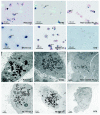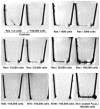Biological properties of iron oxide nanoparticles for cellular and molecular magnetic resonance imaging
- PMID: 21339973
- PMCID: PMC3039939
- DOI: 10.3390/ijms12010012
Biological properties of iron oxide nanoparticles for cellular and molecular magnetic resonance imaging
Abstract
Superparamagnetic iron-oxide particles (SPIO) are used in different ways as contrast agents for magnetic resonance imaging (MRI): Particles with high nonspecific uptake are required for unspecific labeling of phagocytic cells whereas those that target specific molecules need to have very low unspecific cellular uptake. We compared iron-oxide particles with different core materials (magnetite, maghemite), different coatings (none, dextran, carboxydextran, polystyrene) and different hydrodynamic diameters (20-850 nm) for internalization kinetics, release of internalized particles, toxicity, localization of particles and ability to generate contrast in MRI. Particle uptake was investigated with U118 glioma cells und human umbilical vein endothelial cells (HUVEC), which exhibit different phagocytic properties. In both cell types, the contrast agents Resovist, B102, non-coated Fe(3)O(4) particles and microspheres were better internalized than dextran-coated Nanomag particles. SPIO uptake into the cells increased with particle/iron concentrations. Maximum intracellular accumulation of iron particles was observed between 24 h to 36 h of exposure. Most particles were retained in the cells for at least two weeks, were deeply internalized, and only few remained adsorbed at the cell surface. Internalized particles clustered in the cytosol of the cells. Furthermore, all particles showed a low toxicity. By MRI, monolayers consisting of 5000 Resovist-labeled cells could easily be visualized. Thus, for unspecific cell labeling, Resovist and microspheres show the highest potential, whereas Nanomag particles are promising contrast agents for target-specific labeling.
Keywords: cellular localization; electron microscopy; iron oxide nanoparticles; iron staining; magnetic resonance imaging (MRI); toxicity; uptake kinetics.
Figures






Similar articles
-
[Labeling of mesenchymal stem cells with different superparamagnetic particles of iron oxide and detectability with MRI at 3T].Rofo. 2005 Aug;177(8):1151-63. doi: 10.1055/s-2005-858330. Rofo. 2005. PMID: 16021549 German.
-
Magnetic labeling of non-phagocytic adherent cells with iron oxide nanoparticles: a comprehensive study.Contrast Media Mol Imaging. 2008 Nov-Dec;3(6):223-32. doi: 10.1002/cmmi.256. Contrast Media Mol Imaging. 2008. PMID: 19072771
-
Impact of surface coating and particle size on the uptake of small and ultrasmall superparamagnetic iron oxide nanoparticles by macrophages.Int J Nanomedicine. 2012;7:5415-21. doi: 10.2147/IJN.S33709. Epub 2012 Oct 10. Int J Nanomedicine. 2012. PMID: 23091384 Free PMC article.
-
Poly(N,N-dimethylacrylamide)-coated maghemite nanoparticles for labeling and tracking mesenchymal stem cells.2009 Dec 23 [updated 2010 Feb 16]. In: Molecular Imaging and Contrast Agent Database (MICAD) [Internet]. Bethesda (MD): National Center for Biotechnology Information (US); 2004–2013. 2009 Dec 23 [updated 2010 Feb 16]. In: Molecular Imaging and Contrast Agent Database (MICAD) [Internet]. Bethesda (MD): National Center for Biotechnology Information (US); 2004–2013. PMID: 20641410 Free Books & Documents. Review.
-
Iron oxide based MR contrast agents: from chemistry to cell labeling.Curr Med Chem. 2009;16(35):4712-27. doi: 10.2174/092986709789878256. Curr Med Chem. 2009. PMID: 19903138 Review.
Cited by
-
Superparamagnetic iron oxide nanoparticles: magnetic nanoplatforms as drug carriers.Int J Nanomedicine. 2012;7:3445-71. doi: 10.2147/IJN.S30320. Epub 2012 Jul 6. Int J Nanomedicine. 2012. PMID: 22848170 Free PMC article. Review.
-
Magnetic nanoparticles in magnetic resonance imaging and diagnostics.Pharm Res. 2012 May;29(5):1165-79. doi: 10.1007/s11095-012-0711-y. Epub 2012 Mar 6. Pharm Res. 2012. PMID: 22392330 Review.
-
Intracellular Delivery of siRNA by Polycationic Superparamagnetic Nanoparticles.J Drug Deliv. 2012;2012:218940. doi: 10.1155/2012/218940. Epub 2012 Aug 30. J Drug Deliv. 2012. PMID: 22970377 Free PMC article.
-
Re-assessing the enhanced permeability and retention effect in peripheral arterial disease using radiolabeled long circulating nanoparticles.Biomaterials. 2016 Sep;100:101-9. doi: 10.1016/j.biomaterials.2016.05.018. Epub 2016 May 21. Biomaterials. 2016. PMID: 27254470 Free PMC article.
-
Accelerated Blood Clearance Phenomenon Reduces the Passive Targeting of PEGylated Nanoparticles in Peripheral Arterial Disease.ACS Appl Mater Interfaces. 2016 Jul 20;8(28):17955-63. doi: 10.1021/acsami.6b05840. Epub 2016 Jul 7. ACS Appl Mater Interfaces. 2016. PMID: 27340833 Free PMC article.
References
-
- Grimm J, Kircher M, Weissleder R. Cell tracking: Principles and applications. Radiologe. 2007;47:25–33. - PubMed
-
- Yoo BM, Pagel D. An overview of responsive MRI contrast agents for molecular imaging. Front. Biosci. 2008;13:1733–1752. - PubMed
-
- Nunn AD, Linder KE, Tweedle MF. Can receptors be imaged with MRI agents? Q. J. Nucl. Med. 1997;41:155–162. - PubMed
-
- Moore A, Weissleder R, Bogdanov A., Jr Uptake of dextran-coated monocrystalline iron oxides in tumor cells macrophages. J. Magn. Reson Imaging. 1997;7:1140–1145. - PubMed
Publication types
MeSH terms
Substances
LinkOut - more resources
Full Text Sources
Other Literature Sources
Medical

